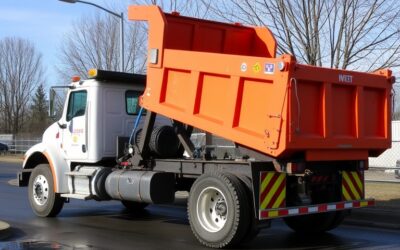Dump truck stability is key to preventing accidents and keeping operations running smoothly. Installing the Wink Anti-Tip device can help keep your trucks stable and safe on the job. A key solution for enhancing dump truck stability is the Wink Anti-Tip device. This advanced system helps prevent tip-overs by automatically adjusting the truck’s unit when necessary. Installing the Wink Anti-Tip device correctly is vital to maximize its effectiveness. In this guide, I will walk you through the process of installing the Wink Anti-Tip device, from understanding the requirements to post-installation tips. This step-by-step guide aims to make the installation process straightforward and easy to follow. Knowing what to expect and how to prepare can make a significant difference in the successful implementation of this safety technology.
By following these instructions, you will be better equipped to install the Wink Anti-Tip device, ensuring that your dump truck operates safely and efficiently. This valuable technology can help avoid tip-over accidents, protect drivers, and save costs associated with dump truck instability. Let’s dive into the details and get started on making your trucks safer with Wink Anti-Tip.
Understanding the Requirements for Wink Anti-Tip Installation
Before you start, make sure your truck is compatible with the Wink Anti-Tip system. Whether you’re using a frameless dump truck, Roll Off truck, or frame-type truck, confirming compatibility will save you time and prevent issues later. First and foremost, you need to make sure that your truck model is compatible with the Wink Anti-Tip system. This technology is designed for frameless dump trucks, Roll Off dump trucks, and frame type dump trucks. Confirming compatibility will save time and prevent complications during installation.
Next, gather all the necessary tools and equipment. You’ll need basic tools like wrenches, screwdrivers, and pliers, as well as any specialized equipment recommended by the device’s installation manual. It’s also advisable to have a clean, well-lit workspace to facilitate a smooth installation process. Ensuring you have everything on hand before you start will make the installation more efficient and less stressful.
Essential Pre-Installation Inspections and Checks
Before you install, inspect your truck’s frame, suspension, and hydraulic systems to ensure everything is in top shape. Fixing any issues beforehand will make installation smoother and safer. Start by examining the truck’s frame and suspension system. Look for any signs of wear and tear, such as rust, cracks, or loose bolts, which could affect the stability and effectiveness of the anti-tip system. Repair or replace any damaged components before proceeding with the installation.
Additionally, inspect the hydraulic system if your dump truck uses one. Check for leaks, damaged hoses, or low fluid levels. A malfunctioning hydraulic system can compromise the performance of the Wink Anti-Tip device. Lastly, ensure that the electrical system is in good working order, as the device will likely require a reliable power source. Conducting these inspections and checks will help provide a solid foundation for a successful installation, ensuring that the Wink Anti-Tip device can operate effectively and safely.
Step-by-Step Wink Anti-Tip Installation Guide
Ready to install? Here’s a step-by-step breakdown of how to get your Wink Anti-Tip device installed correctly, ensuring maximum safety on the road. First, make sure you have all necessary tools at hand, including wrenches, screwdrivers, and the installation manual. Begin by positioning the Wink Anti-Tip unit on the dump truck’s frame, ensuring it’s securely placed to offer optimal balance and functionality.
Next, connect the device to the truck’s power supply following the instructions in the manual. Secure all electrical connections tightly to prevent any disconnections during operation. Once the device is connected, mount the sensors in locations that will effectively monitor the truck’s tilt. Ensure that these sensors are firmly attached and calibrated correctly. After sensor installation, test the system by simulating different loading conditions to check if the Wink Anti-Tip unit responds appropriately. Make any necessary adjustments to fine-tune the system for optimal performance.
Post-Installation Tips for Ensuring Maximum Safety
Now that your Wink Anti-Tip device is installed, regular maintenance is key to keeping it functioning at its best. Here are a few tips to ensure long-term safety and performance. Regular maintenance checks are crucial. Periodically inspect all connections, sensors, and calibration settings to make sure everything is functioning correctly. This helps in identifying any wear and tear that might impact the system’s performance.
Driver training is another essential aspect. Ensure that all operators are familiar with the features of the Wink Anti-Tip device, including how to respond to alerts. A well-informed driver can make better decisions on the road, further enhancing safety. Additionally, integrate the use of the Wink Anti-Tip system into your standard operating procedures. Make it a requirement for drivers to perform pre-trip checks focusing on the device to confirm it’s operational before hitting the road. By incorporating these post-installation practices, you can maximize the benefits of the Wink Anti-Tip device over the long term.
Final Thoughts
Dump truck stability is crucial for safe operations in industries like construction and mining. By installing and maintaining the Wink Anti-Tip device, you ensure a safer, more efficient work environment for your fleet. From understanding common stability issues to installing the Wink Anti-Tip device and following post-installation tips, each step plays a significant role in enhancing safety. The Wink Anti-Tip device not only provides real-time stability checks but also empowers drivers to take corrective actions immediately, reducing the risk of accidents and improving operational efficiency.
Taking the time to properly install and maintain the Wink Anti-Tip system brings long-term benefits, contributing to a safer work environment and extending the lifespan of your vehicle. Integrating these practices will help create a more reliable fleet, capable of handling the challenges posed by carrying heavy and uneven loads.
For those looking to improve the stability of their dump trucks and ensure a safer working environment, Wink Anti-Tip technology is an invaluable investment. Learn more about how our solutions can meet your specific needs. Equip your dump trucks with the best in stability technology today!





